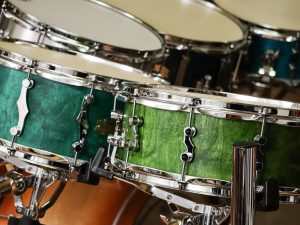
If only we all could ask the greatest players of every instrument, like Vinnie, such questions.
Something tells me there’d be a lot fewer Chinese knock-offs in our kits!
If you’re new to the snare world, or even drums in general, welcome!! It’s a world of laughter! A world of tears! It’s a….oh, no, wait that’s…something else entirely….
Actually, It’s a world of cool, crackin’ sounds that move yo’ booty and sing like Hootie! And, as I tell my students, playing drums has an aggressive, barbaric, ‘Incredible Hulk’ kind of vibe that I don’t get from any other instrument. When drums play it’s not just a sound…it’s an INVASION!!
If you’re trying to find out what the best beginner snare drum is, then I’m guessing you’re coming from one of two potential places:
- You’re a young rocker who wants to learn some radio songs and get noticed by the opposite sex, or
- You’re in school, starting to play in the marching band, you’re looking for a concert snare and you haven’t yet been noticed by the opposite sex.
KIDDING!! Well….kind of. I’ve been in both places so…there’s a nugget of truth in each. Hah!
In any case, let’s take a look at each scenario to find the best beat for your buck…
“The Snares Go Marching Two by Two, Hoorah! Hoorah!”
Most of the time schools will have their own marching snares
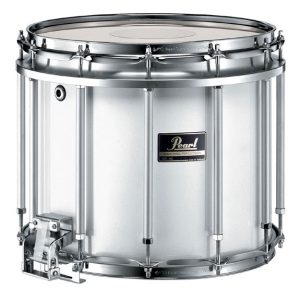
to hand out to those wishing to hit things, but not always.
If you do want to buy your own there are perks: having your own instrument carries with it a bit of clout and sets you apart as one who is more “serious, dude’ about your percussive mission.
Also, it will probably be in much better shape than the snares the schools has, since they’ve been dropped, rolled, hit, thrown….who knows what, for God knows how long!
Not that you have to have the greatest snare in the world starting out anyway. As long as the snare wires (the jangly metal or plastic screen-looking thing on the bottom head) and the strainer (the blocky lever on the side of the drum that engages or disengages the snares, changing the sound dramatically) are working, and you have a good head on the drum (the skin or polymer that you actually hit) you’ll probably be just fine.
If you’re buying a snare for school, however, it’s imperative that you ask your teacher what parameters you need to stay within if you want to use it with the marching band. What size? What color?
The biggest issue is snare depth. Most marching bands will want you to have a marching snare – one that’s 12 inches deep and 14 inches wide. This is much deeper than a snare you’d find on a drum kit. So if you’re wanting a snare that can serve for marching AND for a home kit, you’re probably out of luck.
Again though, you must ask your band director. He or she will probably give you excellent advice and know some local options for you to shop as well.
Also, what many students who like drumming do is use the school’s deep snare for marching and invest in their own drum kit snare for home use. Sammy says it’s the best of both worlds.
Anybody…little VH love? Anyone??
Time to Sit, Behind the kit
On the other hand, maybe you’re the guy or girl who is NOT in marching band, but rather just really likes the thought of layin’ down a smooove grooooove and bein’ the foundation of a modern-day pop, rock or jazz band.
Well, your options are practically limitless. There are SOOOOOooooo many snare styles, brands, looks and sizes, it’ll turn your head around like a cold wind blowin’. Right, James?
The most typical snare in a kit is probably the 14″ x 5″, and that’s a great place to start so you get in your mind what a “normal” snare sound is and how to work it. Then, when future G.A.S. attacks occur, you can stomp and wail and cry out for the need, the absolute need for…
…a smaller snare:
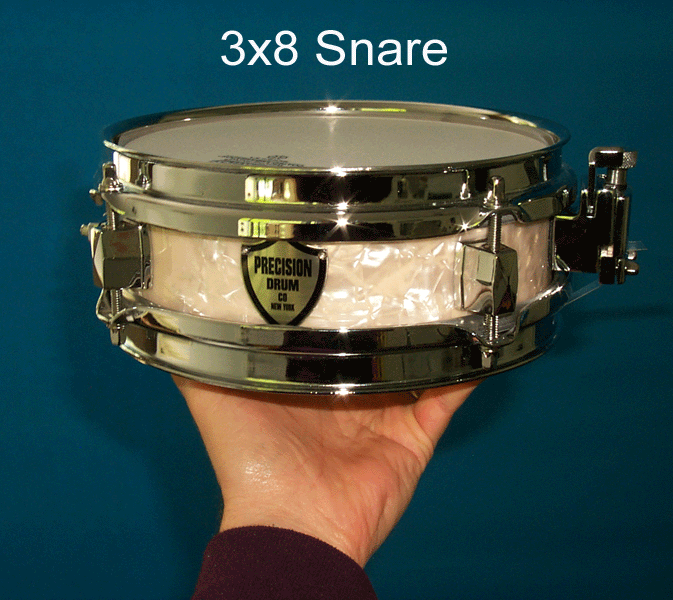
Or a spiky snare:
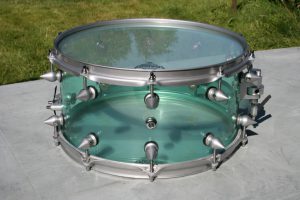
Or your favorite band’s snare!
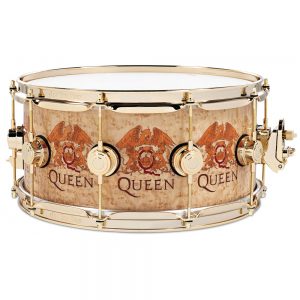
Or even your favorite TV show’s snare!!!
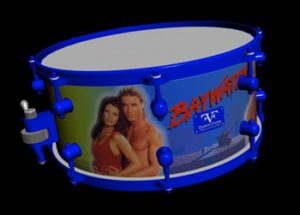
Whatever floats Baywatch Bob’s boat, it’s best to start on a classic snare, and that’s a 14×5 or 14×5.5. From there the options are limitless.
But if you don’t go with the classic size up front, just know that there’s more than one way to skin a snare…
Size Matters
It’s going to make you a much more flexible, desirable drummer if you remember this: no matter what size of snare you get, the tightness of the head will be a big determining factor in the sound. If it’s stretched a lot, you’ll get a high cracking, tight sound. If loosened, it’ll be more subtle, appropriate for ballads and such.
But, as with every instrument, it’s so subjective. Just know that part of the fun of drums is tuning them. They don’t just have one sound. Get in there and play with those lugs (the tension rods that allow you to tighten or loosen the head) – twist ’em up, twist ’em down; listen to the difference in how the drum sounds when you hit through the changes.
Any given drum has quite a few voices if you give it a chance to sing in different registers.
My aluminum snare has been known to growl like Freddy Mercury sometimes. :-p
Bang the Best. Leave the Rest.
It’s been said many times in the music world, but I’ll repeat it here because it’s always a good slogan to live by: buy the best instrument you can afford. Is it true that playing on a quality piece of gear is a more pleasant experience than playing on a cheap one? In almost every instance, yes.
Sometimes when you’re just starting an instrument you actually don’t know what a good one sounds and feels like. Because of that you could play on your $10 Fisher Price plastic djembe and think you’re summoning up the spirits of ancient Kenya, it’s so compelling! But in actuality…it probably leaves a little to be desired. That’s more obvious at times than others.
Case in point: my first guitar. A relative gave it to me. Probably was in their attic behind floor tiles and great-grandma Rebekah’s 1800s church clothes.
It had terrible action on the strings; they were so high off the neck I thought I was the worst weakling wannabe ever.
Then one day… I went over to my bud’ Brian’s house. He had a nice Martin. I picked it up. I played an E.
It felt and sounded like a totally different instrument.

Definitely play on as many drums as you can. Yours. Your friend’s. The music store’s. The more you investigate, the wider your aural world will become.
At the beginning tho’…just get the highest quality you can for the money, even if you’re only spending $50.
Stockpiling Your Snare Arsenal
I also want to warn you: this site is called Serious G.A.S. for a reason. Once you start down this road of really being able to hear and recognize the differences in drums, I guarantee you – you’re going to want at LEAST one more.
And then another.
And then a smaller one.
And then a bigger one!
And then one made of maple, ‘cuz, come on, every pro kit has a good maple!!
And then, “Hey, wait – is that a DRUM SALE I see advertised??!!!!”
This is why I have a Ludwig 14×5 Supraphonic (circa early 80s) snare:
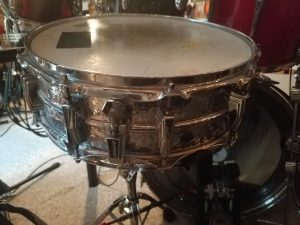
A Pacific 14×6 birch snare:
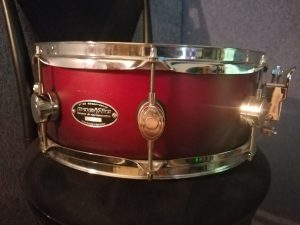
A 1980 Ludwig 14×6 Supraphonic (circa mid 80s) snare:
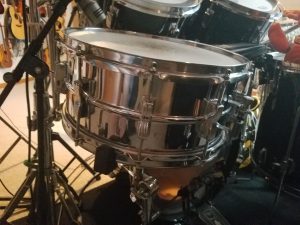
AND a PDP Limited Edition Maple/Walnut 14”x7.5” snare:
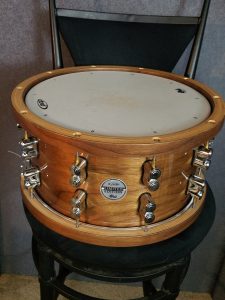
Each one is very cool, but very different. I choose the right snare for whatever current song I’m recording, and it melts into your hot, steamy ears like BUTTER!!
I’m telling ya. Gear Acquisition Syndrome never ends. It just gets more picky, because your ears get more picky.
The Day the Cilia Died
And speaking of ears, every drum student I teach gets this admonishment, for very good reason: WEAR HEADPHONES!!
I never, ever, ever, EVER practice my drums without ear protection. In fact, I don’t even go to concerts without taking earplugs. Once you’ve fried the sensory cells that look like little hairs in your ear (they translate vibration into sound) they are gone. Gone!
And they don’t grow back.
Drums can be loud. VERY loud. And if you’re on a drum kit, the cymbals too are so loud and piercing it can actually hurt if you’re getting the full brunt of their power.
I auditioned for a Journey cover band once, playing bass, and the drummer didn’t like it that I wouldn’t play without in-ear protection. I lost the gig, but saved my hearing.
I easily came out ahead on that one. So should you.

If the biological facts don’t convince you, consider this: great musicians through the decades have lost their hearing because of the electrification of instruments that rock music ushered in loudly. Legends like Phil Collins, Pete Townsend, Ozzy, Eric Clapton, Brian Wilson, Chris Martin….they all have varying levels of hearing loss.
And, trust me, they wish they didn’t. Don’t be that guy, or girl. Protect your hearing so you can have a lifetime of performing and enjoying your music. It really sucks when that ability is taken away.
“I Just Wanna Bang on the Drum All Day….!”
Once you’ve bought your first snare drum, you’ll want to…practice! At least, we hope so. That’s where the FUN is!
If there’s anything that irks my smirk it’s seeing an instrument alone and unwanted in some corner that never gets to sing or shine ‘cuz it’s being TOTALLY IGNORED. Don’t cause your instrument to run away to Sgt. Pepper – get on it and bang away. Just 10 minutes a day can really advance your skills and let you see the possibilities that lie innate inside you.
Not so into it today? One sure way of eliminating the drudgery is to always start by putting on your favorite music and playing along to it. Even if you haven’t learned the song, play it anyway. Play it for the sheer enjoyment of it.
Then you can move on to studying something specific. But if you start with a smile, you’ll probably end with one. 😉
It’s a Hit!
So, in a nutshell, the best beginning snare drum is what you have money for, either with a classical school band or a modern-radio-songs band in mind.
Practice for the fun of it, wear ear protection and prepare for a lifetime of audio awesomeness as you pursue an extremely versatile instrument that is so crucial to music today and into the future – the SNARE DRUM!
You’re gonna LOVE IT!!
Now….go….make…sounds!
Teaj

Thank you for reading! Yea, I try to make the blog not only informative, but FUN! Since we tend to go back to things that are enjoyable, maybe I’ll see people just like you, Steph…again!
Great to hear from you, Vennick! If you’re interested in playing drums, it’s NEVER TOO LATE! And thanks to some selling websites these days, you can get a STEAL for little money. For example, I picked up my first drum kit for only $270 off of Craigslist! That was for a kick, snare, three toms, all the hardware, 5 cymbals and even a rolling cart/box to haul them all in for gigs! Amazing!!!
Definitely read these two other posts on my site and I believe your questions will be answered:
– How to buy music gear online
– Discount Music Gear
If you still have questions after those, lemme know and I’ll answer anything else you might be uncertain about. I love to help! Maybe that’s why I teach. 😉
I love your enthusiasm and humor that jumps out as you read this article! You make picking the right snare drum, a snap. And a joy.
Showcasing the many variations of snares simplifies the research process of choosing which route to go. Personally, the Baywatch snare is pretty amazing.
Thank you for such an informative article!
Wow! Thankyou for the awesome post and overall site. I have always been interested in actually playing the drums. I have always been banging sticks on them just for fun. I didn’t even know what the snare was until this, honestly!
Though, what drum purchasing platform should I use? Would it be better to buy from Amazon with your insight or go to a music store with the store clerk’s changing advice?